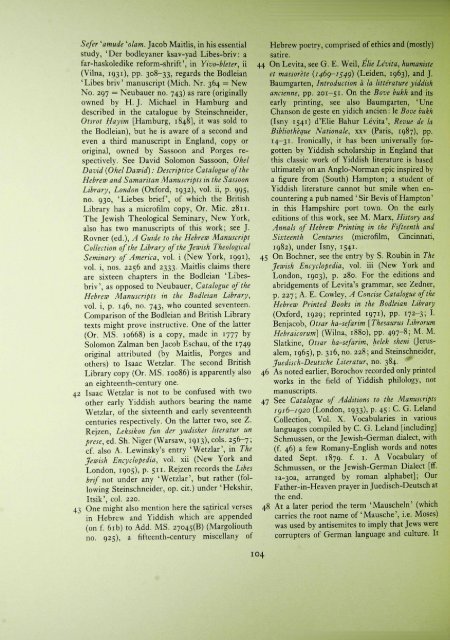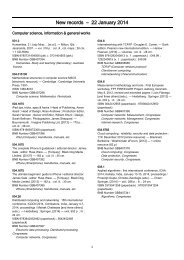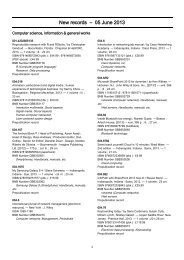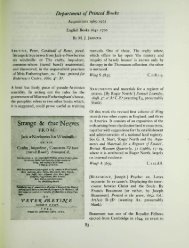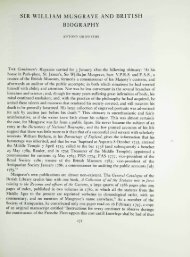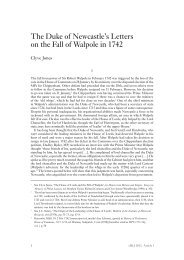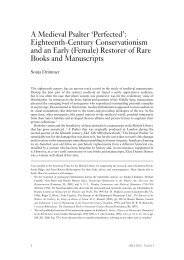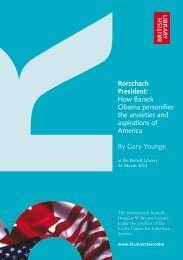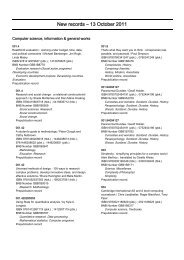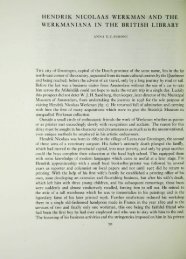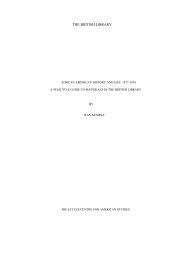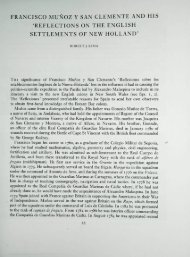YIDDISH MANUSCRIPTS IN THE BRITISH LIBRARY
YIDDISH MANUSCRIPTS IN THE BRITISH LIBRARY
YIDDISH MANUSCRIPTS IN THE BRITISH LIBRARY
You also want an ePaper? Increase the reach of your titles
YUMPU automatically turns print PDFs into web optimized ePapers that Google loves.
Sefer 'amude 'olam. Jacob Maitlis, in his essential<br />
study, 'Der bodleyaner ksav-yad Libes-briv: a<br />
far-haskoledike reform-shrift', in Yivo-bleter, ii<br />
(Vilna, 1931), pp. 308-33, regards tbe Bodleian<br />
'Libes briv' manuscript (Mich. Nr. 364 = New<br />
No. 297 = Neubauer no. 743) as rare (originally<br />
owned by H. J. Michael in Hamburg and<br />
described in the catalogue by Steinschneider,<br />
Otsrot Hayim [Hamburg, 1848], it was sold to<br />
the Bodleian), but he is aware of a second and<br />
even a third manuscript in England, copy or<br />
original, owned by Sassoon and Porges respectively.<br />
See David Solomon Sassoon, Ohel<br />
David {Ohel Dawid): Descriptive Catalogue of the<br />
Hebrew and Samaritan Manuscripts in the Sassoon<br />
Library, London (Oxford, 1932), vol. ii, p. 995,<br />
no. 930, 'Liebes brief, of which the British<br />
Library has a microfilm copy. Or. Mic. 2811.<br />
The Jewish Theological Seminary, New York,<br />
also has two manuscripts of this work; see J.<br />
Rovner (ed.), A Guide to the Hebrew Manuscript<br />
Collection of the Library of the Jewish Theological<br />
Seminary of America, vol. i (New York, 1991),<br />
vol. i, nos. 2256 and 2333. Maitlis claims there<br />
are sixteen chapters in the Bodleian 'Libesbriv',<br />
as opposed to Neubauer, Catalogue of the<br />
Hebrew Manuscripts m the Bodleian Library,<br />
vol. i, p. 146, no. 743, who counted seventeen.<br />
Comparison of the Bodleian and British Library<br />
texts might prove instructive. One of the latter<br />
(Or. MS. 10668) is a copy, made in 1777 by<br />
Solomon Zalman ben Jacob Eschau, of the 1749<br />
original attributed (by Maitlis, Porges and<br />
others) to Isaac Wetzlar. The second British<br />
Library copy (Or. MS. 10086) is apparently also<br />
an eighteenth-century one.<br />
42 Isaac Wetzlar is not to be confused with two<br />
other early Yiddish authors bearing the name<br />
Wetzlar, of the sixteenth and early seventeenth<br />
centuries respectively. On the latter two, see Z.<br />
Rejzen, Leksikon fun der yudisher literatur un<br />
;)rf5f, ed. Sh. Niger (Warsaw, 1913), cols. 256-7;<br />
cf. also A. Lewinsky's entry 'Wetzlar', in The<br />
Jewish Encyclopedia, vol. xii (New York and<br />
London, 1905), p. 511. Rejzen records the Libes<br />
hrif not under any 'Wetzlar', but rather (following<br />
Steinschneider, op. cit.) under 'Hekshir,<br />
Itsik', col. 220.<br />
43 One might also mention here the satirical verses<br />
in Hebrew and Yiddish which are appended<br />
(on f. 6ib) to Add. MS. 27O45(B) (Margoliouth<br />
no. 925), a fifteenth-century miscellany of<br />
Hebrew poetry, comprised of ethics and (mostly)<br />
satire.<br />
44 On Levita, see G. E. Weil, EUe Levita^ humaniste<br />
et massorete {i46g-iS49) (Leiden, 1963), and J.<br />
Baumgarten, Introduction a la Utterature yiddish<br />
ancienne, pp. 201-51. On the Bove bukh and its<br />
early printing, see also Baumgarten, ' Une<br />
Chanson de geste en yidich ancien: le Bove bukh<br />
(Isny 1541) d'EIie Bahur Levita', Revue de la<br />
Bibliotheque Nationale, xxv (Paris, 1987), pp.<br />
14-31. Ironically, it has been universally forgotten<br />
by Yiddish scholarship in England that<br />
this classic work of Yiddish literature is based<br />
ultimately on an Anglo-Norman epic inspired by<br />
a figure from (South) Hampton; a student of<br />
Yiddish literature cannot but smile when encountering<br />
a pub named ' Sir Bevis of Hampton'<br />
in this Hampshire port town. On the early<br />
editions of this work, see M. Marx, History and<br />
Annals of Hebrew Printing in the Fifteenth and<br />
Sixteenth Centuries (microfilm, Cincinnati,<br />
1982), under Isny, 1541.<br />
45 On Bochner, see the entry by S. Roubin in The<br />
Jewish Encyclopedia, vol. iii (New York and<br />
London, 1903), p. 280. For the editions and<br />
abridgements of Levita's grammar, see Zedner,<br />
p. 227; A. E. Cowley, A Concise Catalogue of the<br />
Hebrew Printed Books in the Bodleian Library<br />
(Oxford, 1929; reprinted 1971), pp. 172-3; I-<br />
Benjacob, Otsar ha-sefarim [Thesaurus Librorum<br />
Hebraicorum] (Wilna, 1880), pp. 497-8; M. M.<br />
Slatkine, Otsar ha-sefarim, helek sheni (Jerusalem,<br />
1965), p. 316, no. 228; and Steinschneider,<br />
Juedisch-Deutsche Literatur, no. 384. *"<br />
46 As noted earlier, Borochov recorded only printed<br />
works in the field of Yiddish philology, not<br />
manuscripts.<br />
47 See Catalogue of Additions to the Manuscripts<br />
104<br />
igi6-ig20 (London, 1933), p. 45- C. G. Leland<br />
Collection, Vol. X. Vocabularies in various<br />
languages compiled by C. G. Leland [including]<br />
Schmussen, or the Jewish-German dialect, with<br />
(f. 46) a few Romany-English words and notes<br />
dated Sept. 1879. f. i. A Vocabulary of<br />
Schmussen, or the Jewish-German Dialect [ff.<br />
ia-3oa, arranged by roman alphabet]; Our<br />
Father-in-Heaven prayer in Juedisch-Deutsch at<br />
the end.<br />
48 At a later period the term 'Mauschein' (which<br />
carries the root name of 'Mausche', i.e. Moses)<br />
was used by antisemites to imply that Jews were<br />
corrupters of German language and culture. It


